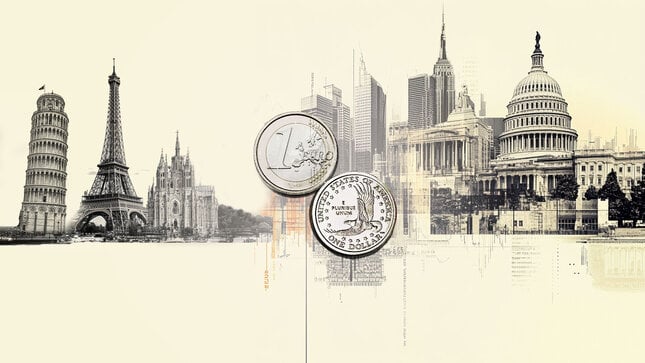- EUR/USD trade marginally higher on the day near 1.1000 in the European session.
- ECB officials voice support for further policy easing at next week's meeting.
- The pair could extend recovery once it manages to stabilize above 1.1000.
EUR/USD continues to edge higher toward 1.1000 after posting small gains on Monday. Relatively dovish comments from European Central Bank (ECB) officials and the sour market mood, however, could cap the pair's upside in the near term.
Euro PRICE This week
The table below shows the percentage change of Euro (EUR) against listed major currencies this week. Euro was the strongest against the Australian Dollar.
| USD | EUR | GBP | JPY | CAD | AUD | NZD | CHF | |
|---|---|---|---|---|---|---|---|---|
| USD | -0.18% | 0.15% | -0.75% | 0.51% | 0.90% | 0.52% | -0.55% | |
| EUR | 0.18% | 0.40% | -0.54% | 0.73% | 1.07% | 0.70% | -0.39% | |
| GBP | -0.15% | -0.40% | -0.97% | 0.31% | 0.67% | 0.34% | -0.66% | |
| JPY | 0.75% | 0.54% | 0.97% | 1.26% | 1.64% | 1.22% | 0.24% | |
| CAD | -0.51% | -0.73% | -0.31% | -1.26% | 0.41% | 0.00% | -1.05% | |
| AUD | -0.90% | -1.07% | -0.67% | -1.64% | -0.41% | -0.32% | -1.40% | |
| NZD | -0.52% | -0.70% | -0.34% | -1.22% | -0.01% | 0.32% | -1.03% | |
| CHF | 0.55% | 0.39% | 0.66% | -0.24% | 1.05% | 1.40% | 1.03% |
The heat map shows percentage changes of major currencies against each other. The base currency is picked from the left column, while the quote currency is picked from the top row. For example, if you pick the Euro from the left column and move along the horizontal line to the US Dollar, the percentage change displayed in the box will represent EUR (base)/USD (quote).
The US Dollar (USD) struggled to build on the previous week's gains on Monday and allowed EUR/USD to hold its ground. Nevertheless, the risk-averse market atmosphere, as reflected by sharp declines seen in Wall Street's main indexes, made it difficult for the pair to push higher.
In an interview with the Slovenian daily, Delo, on Tuesday, Frank Elderson, Vice-Chair of the Supervisory Board at the ECB, warned of economic growth risks materializing, adding that he is open-minded about the next policy action ahead of the October meeting. Meanwhile, ECB policymaker Martins Kazaks argued that inflation is not fully defeated but said that data point to an interest rate cut next week.
The US economic calendar will not offer any high-impact data releases in the second half of the day. Hence, investors are likely to pay close attention to the risk perception. In the European session, US stock index futures trade virtually unchanged. In case the safe-haven flows dominate the market action in the American session, EUR/USD could struggle to extend its rebound.
EUR/USD Technical Analysis
The Relative Strength Index (RSI) indicator on the 4-hour chart recovered above 40 early Tuesday, pointing to a weakening in bearish pressure. Looking north, immediate resistance could be spotted at 1.1000 (round level, Fibonacci 50% retracement of the latest uptrend) before 1.1040 (Fibonacci 38.2% retracement) and 1.1100 (Fibonacci 23.6% retracement).
On the downside, supports align at 1.0950 (Fibonacci 61.8% retracement), 1.0900 (round level) and 1.0870 (Fibonacci 78.6% retracement).
Euro FAQs
The Euro is the currency for the 19 European Union countries that belong to the Eurozone. It is the second most heavily traded currency in the world behind the US Dollar. In 2022, it accounted for 31% of all foreign exchange transactions, with an average daily turnover of over $2.2 trillion a day. EUR/USD is the most heavily traded currency pair in the world, accounting for an estimated 30% off all transactions, followed by EUR/JPY (4%), EUR/GBP (3%) and EUR/AUD (2%).
The European Central Bank (ECB) in Frankfurt, Germany, is the reserve bank for the Eurozone. The ECB sets interest rates and manages monetary policy. The ECB’s primary mandate is to maintain price stability, which means either controlling inflation or stimulating growth. Its primary tool is the raising or lowering of interest rates. Relatively high interest rates – or the expectation of higher rates – will usually benefit the Euro and vice versa. The ECB Governing Council makes monetary policy decisions at meetings held eight times a year. Decisions are made by heads of the Eurozone national banks and six permanent members, including the President of the ECB, Christine Lagarde.
Eurozone inflation data, measured by the Harmonized Index of Consumer Prices (HICP), is an important econometric for the Euro. If inflation rises more than expected, especially if above the ECB’s 2% target, it obliges the ECB to raise interest rates to bring it back under control. Relatively high interest rates compared to its counterparts will usually benefit the Euro, as it makes the region more attractive as a place for global investors to park their money.
Data releases gauge the health of the economy and can impact on the Euro. Indicators such as GDP, Manufacturing and Services PMIs, employment, and consumer sentiment surveys can all influence the direction of the single currency. A strong economy is good for the Euro. Not only does it attract more foreign investment but it may encourage the ECB to put up interest rates, which will directly strengthen the Euro. Otherwise, if economic data is weak, the Euro is likely to fall. Economic data for the four largest economies in the euro area (Germany, France, Italy and Spain) are especially significant, as they account for 75% of the Eurozone’s economy.
Another significant data release for the Euro is the Trade Balance. This indicator measures the difference between what a country earns from its exports and what it spends on imports over a given period. If a country produces highly sought after exports then its currency will gain in value purely from the extra demand created from foreign buyers seeking to purchase these goods. Therefore, a positive net Trade Balance strengthens a currency and vice versa for a negative balance.
Information on these pages contains forward-looking statements that involve risks and uncertainties. Markets and instruments profiled on this page are for informational purposes only and should not in any way come across as a recommendation to buy or sell in these assets. You should do your own thorough research before making any investment decisions. FXStreet does not in any way guarantee that this information is free from mistakes, errors, or material misstatements. It also does not guarantee that this information is of a timely nature. Investing in Open Markets involves a great deal of risk, including the loss of all or a portion of your investment, as well as emotional distress. All risks, losses and costs associated with investing, including total loss of principal, are your responsibility. The views and opinions expressed in this article are those of the authors and do not necessarily reflect the official policy or position of FXStreet nor its advertisers. The author will not be held responsible for information that is found at the end of links posted on this page.
If not otherwise explicitly mentioned in the body of the article, at the time of writing, the author has no position in any stock mentioned in this article and no business relationship with any company mentioned. The author has not received compensation for writing this article, other than from FXStreet.
FXStreet and the author do not provide personalized recommendations. The author makes no representations as to the accuracy, completeness, or suitability of this information. FXStreet and the author will not be liable for any errors, omissions or any losses, injuries or damages arising from this information and its display or use. Errors and omissions excepted.
The author and FXStreet are not registered investment advisors and nothing in this article is intended to be investment advice.
Recommended Content
Editors’ Picks

EUR/USD accelerates losses to 1.0930 on stronger Dollar
The US Dollar's recovery regains extra impulse sending the US Dollar Index to fresh highs and relegating EUR/USD to navigate the area of daily troughs around 1.0930 in the latter part of Friday's session.

GBP/USD plummets to four-week lows near 1.2850
The US Dollar's rebound keep gathering steam and now sends GBP/USD to the area of multi-week lows in the 1.2850 region amid the broad-based pullback in the risk-associated universe.

Gold trades on the back foot, flirts with $3,000
Gold prices are accelerating their daily decline, steadily approaching the critical $3,000 per troy ounce mark as the Greenback's rebound gains extra momentum and US yields tighten their retracement.

Can Maker break $1,450 hurdle as whales launch buying spree?
Maker holds steadily above $1,250 support as a whale scoops $1.21 million worth of MKR. Addresses with a 100k to 1 million MKR balance now account for 24.27% of Maker’s total supply. Maker battles a bear flag pattern as bulls gather for an epic weekend move.

Strategic implications of “Liberation Day”
Liberation Day in the United States came with extremely protectionist and inward-looking tariff policy aimed at just about all U.S. trading partners. In this report, we outline some of the more strategic implications of Liberation Day and developments we will be paying close attention to going forward.

The Best brokers to trade EUR/USD
SPONSORED Discover the top brokers for trading EUR/USD in 2025. Our list features brokers with competitive spreads, fast execution, and powerful platforms. Whether you're a beginner or an expert, find the right partner to navigate the dynamic Forex market.
